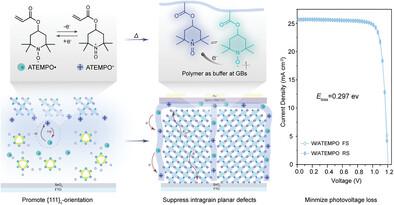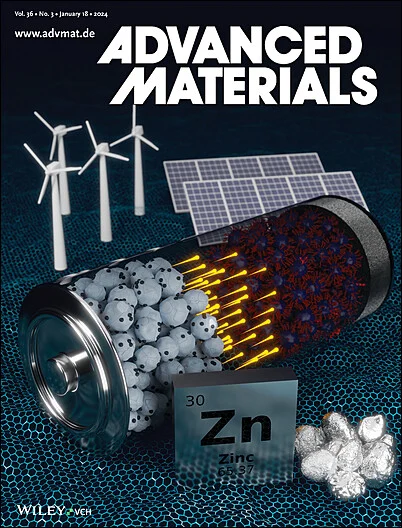Radical Molecular Network-Buffer Minimizes Photovoltage Loss in FAPbI₃ Perovskite Solar Cells
IF 27.4
1区 材料科学
Q1 CHEMISTRY, MULTIDISCIPLINARY
引用次数: 0
Abstract
Formamidinium lead iodide (FAPbI₃) perovskite solar cells (PSCs) hold immense potential for high-efficiency photovoltaics, but maximizing their open-circuit voltage (VOC) remains challenging. Targeting the inherently stable {111}c-dominant facets is a promising approach for enhancing stability, but their formation typically suffers from high defect densities and disordered growth. This study introduces a novel approach using an in situ polymerizable radical molecule, ATEMPO, as an additive to address these issues. ATEMPO preferentially interacts with the {111}c perovskite facets, guiding their growth and forming a “radical molecular network-buffer” upon polymerization. The network effectively mitigates lattice strain, suppresses defect formation, enhances charge transport via redox-mediated hopping, and provides a hydrophobic barrier, significantly improving moisture resistance. This strategy yields high-quality, {111}c -oriented FAPbI₃ films, leading to a champion PCE of 25.28% with a remarkably high VOC of 1.203 V, corresponding to an energy loss (Eloss) of only 0.297 eV, among the highest VOC reported for FAPbI₃-based PSCs. Furthermore, a mini-module fabricate with an active area of 12.5 cm2 achieve a high PCE of 21.39%. the work paves the way for developing high-performance, stable PSCs with minimized photovoltage loss. Furthermore, it offers a promising strategy to enhance device longevity and address environmental concerns.

求助全文
约1分钟内获得全文
求助全文
来源期刊

Advanced Materials
工程技术-材料科学:综合
CiteScore
43.00
自引率
4.10%
发文量
2182
审稿时长
2 months
期刊介绍:
Advanced Materials, one of the world's most prestigious journals and the foundation of the Advanced portfolio, is the home of choice for best-in-class materials science for more than 30 years. Following this fast-growing and interdisciplinary field, we are considering and publishing the most important discoveries on any and all materials from materials scientists, chemists, physicists, engineers as well as health and life scientists and bringing you the latest results and trends in modern materials-related research every week.
 求助内容:
求助内容: 应助结果提醒方式:
应助结果提醒方式:


